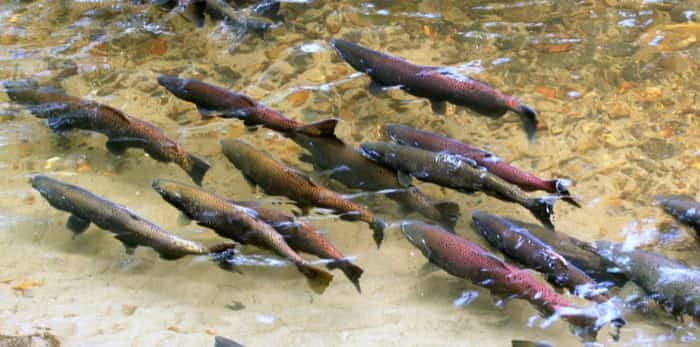 Salmon spawning / Shutterstock
Salmon spawning / Shutterstock
BC’s sport fishing sector is bracing for severe restrictions on fishing for chinook this spring and summer.
They expect the Department of Fisheries and Oceans (DFO) to announce conservation measures this week aimed at protecting king salmon, so called for their size, and the southern resident killer whales that feed on them – measures that could hit the sport fishing sector particularly hard.
“It will take a significant chunk out of [a] $1.1 billion business, and a lot of people will pack it in,” said Dave Steele, owner of Highwater Tackle in North Vancouver.
He said salmon fishing represents about 40% of his business.
“I come up for lease renewal,” he said. “And if they take this percentile away from me, the odds are I won’t renew my lease.”
Sport fishing is a significant part of the economy for many coastal communities, and a number of chambers of commerce on Vancouver Island have expressed concern about the effects of severe restrictions on chinook.
Talk of fishery closures or restrictions makes the sector nervous, because even if the DFO opts for the less draconian of two possible conservation scenarios, it might make anglers who are prepared to spend thousands of dollars on summer fishing trips in B.C. think twice about coming to the province this year.
“The concern … from the recreational sector is ‘Hold on here. You’re willing to float out a proposal that could significantly damage the reputation and opportunity for the recreational sector – $1.1 billion of economic revenues coming into the province every year,” said Owen Bird, executive director for the Sport Fishing Institute of BC.
“At least half of that would be affected if you did something to the South Coast. We’re really hoping cooler heads will prevail.”
Several Fraser River chinook populations have been designated as endangered or threatened by the Committee on the Status of Endangered Wildlife in Canada (COSEWIC).
That alone is enough to trigger restrictions on fishing for king salmon. But there is even greater pressure to reduce the commercial and sport fishing catch because the southern resident killer whale is in decline, and chinook is its main diet.
While fishing may not be the cause of the decline of chinook, fishing restrictions are among the few tools at DFO’s disposal to address a serious decline.
“The question is, are they merited?” said Brian Riddell, president and CEO of the Pacific Salmon Foundation. “Biologically, there is really no question that they are merited.”
DFO has proposed two scenarios for limiting the catch on chinook.
Scenario A, the more draconian, would immediately close the Fraser River tidal area to all salmon fishing until August 23, after which only non-retention fishing for chinook would be allowed. Non-retention restrictions would be in place from April 1 to July 31 in the Strait of Georgia and the Johnstone Strait.
Certain freshwater regions would be completely closed to all salmon fishing, except where there are recreational openings for other salmon species. Commercial troll fisheries would also be closed.
Scenario B would also ban all salmon fishing in the Fraser River tidal area until August 23 but, from April 1 to August 29 in the Strait of Georgia and Johnstone Strait north, would allow one chinook per day to be kept.
For south Georgia Strait, only one hatchery-marked chinook per day could be retained.
Of the 13 Fraser River chinook populations, seven are designated endangered by COSEWIC, and four are deemed threatened. The south and lower Thompson River spring chinook population had a 92% decline in spawner abundance in 2018, compared with the 2013 and 2014 brood years.
Retired DFO scientist Dick Beamish said the decline in chinook numbers and size is a long-term trend that has been occurring throughout the Pacific.
Decreasing harvest levels appear not to have had much of an impact on the decline, he recently wrote in the Island Angler.
“The declines continue despite reductions in fishing and despite the additions of millions of smolts from hatcheries,” he wrote. “I think it is time to recognize that the declines in abundance are large scale.”
While sockeye are the bread and butter for the commercial sector, king salmon and coho are the salmon most prized by the sport sector. But coho went through the kind of decline in the 1990s that chinook are now going through, and they were made largely off limits to fishing in the late 1990s.
However, there are now promising signs of a recovery of coho on the South Coast.
“There’s no question that people are seeing an improving abundance of coho, particularly in southern B.C. waters,” Riddell said. “So there may be opportunities ... to maintain communities through coho salmon.”



